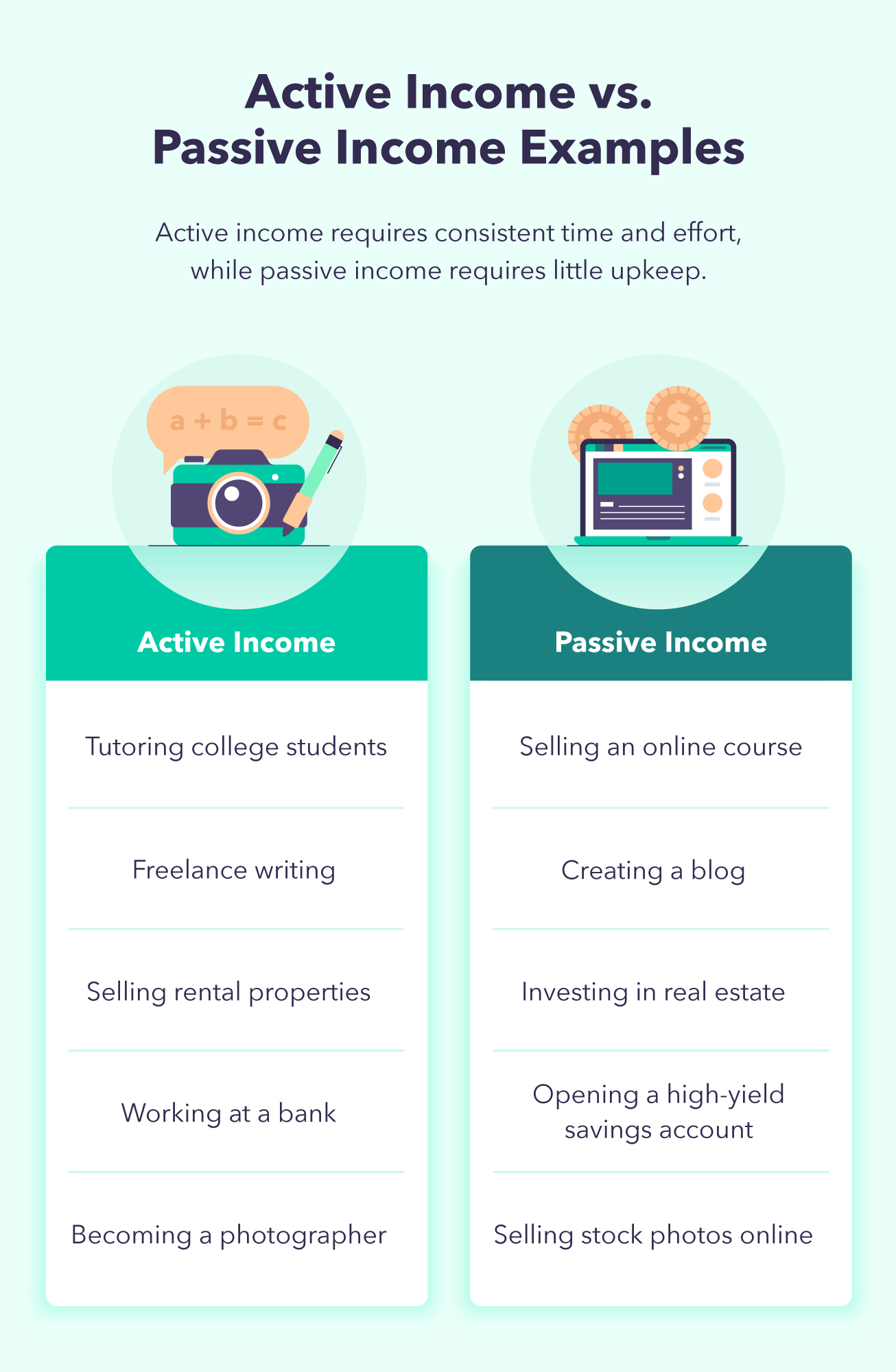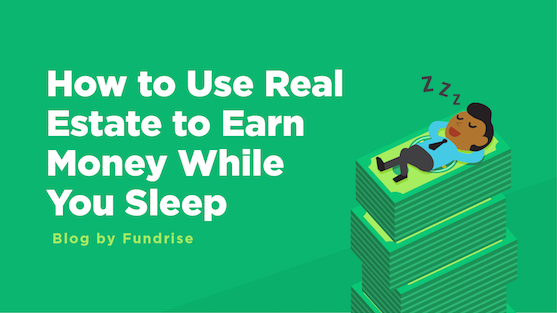Which Is Right for You?
Save more, spend smarter, and make your money go further

There are many different passive income ideas to choose from, especially in today’s world of remote working and flexible schedules. Who knew you could potentially make supplemental income while you sleep? Passive income is the most common solution to do just that. Even though it sounds too good to be true, there are many ways to create passive income streams.
Read on to learn about the different types of passive income opportunities, suggested investment amounts, and the time you may have to put in to earn passive income. You could also simply use the menu below to jump to the one that looks most attractive to you.
Either way, let’s get started.
What Is Passive Income?

Passive income is derived from projects that may require upfront work, but can make you money for little to no upkeep. Creating different passive income streams could be a creative side project that earns supplemental income easily.
Take writing an eBook for instance. If your passion is fitness, you can create a downloadable eBook workout plan. You could focus on your social media audience or your LinkedIn connections to invest in your program. Over time, you’re able to promote your eBook, but since you’ve already created the product, you won’t have to worry about creating something new. Since these types of “products” are categorized as sales, most of the time they’re taxed.
Outside of eBook and online courses, other forms of passive income include renting out properties, investing, or selling your artwork. If you’re ready to start investing and need some additional insight, check out our brokerage page. Continue reading for a more in-depth description on passive income ideas or jump to the infographic.
1. Consider Buying Index Funds
Index funds are normally a mix of stocks or bonds designed to match a specific financial market. Most of the time, you’re able to diversify your investment portfolio rather easily. That way, if one investment goes south, you can have other options to pick up the slack.
- Pro: Typically, these investments can be liquidated in 1-3 business days.
- Con: This type of investment could be considered high risk.
2. Review High Dividend Stocks

For those looking to try investing, high dividend stocks may be for you. High yield dividend stocks are those that have a higher yield than the benchmark average. This type of investment does have higher payoffs, but can get a little riskier. If you consider this option, be sure to read the fine print and calculate your potential earnings.
- Pro: High dividend investments typically bring in a higher dividend rate. This rate could help supplement your yearly income more than other options.
- Con: Some high dividend stock earnings cap out at a certain amount and come with more investment risk.
3. Research Money Market Investment Funds
As for money market investment funds, these can be relatively stable short-term loans. Money market investment funds are highly stable short-term debt securities. The goal of this investment is to earn money from interest. These investments may be backed by high-quality corporate or bank securities.
- Pro: Earnings on these investments can be low risk, but also can be easily liquidated.
- Con: Earnings may be low and fees may apply.
4. Pay Off Some Debt
You could learn how to generate passive income by making larger payments on your outstanding debts. Over time, you could be spending hundreds, or even thousands, on debt interest rates. If you’re looking for different areas to invest, considering paying off debt first.
- Pro: Taking care of your debt can help build your credit. Not to mention, cut long-term investment payments, and free up your budget. Every dollar extra you pay off past your minimum payment goes directly towards paying down your loan principal balance. The lower your principal balance is, the less interest you will pay overall.
- Con: With this option, you aren’t technically earning money, you’re saving money over time.
5. Examine Real Estate Opportunities

If you’re ready to settle down in one area for about three to five years, investing in a home may be a topic of interest. While renting can be rather simplistic, your payments aren’t contributing to an investment. Instead, purchasing a home will allow you to contribute monthly payments to an investment that could earn you money if you were to sell in the future.
- Pro: Over time, your housing investment could grow in value earning you equity in your home.
- Con: You may have to deal with more upkeep and repairs compared to renting your living space. Plus, your home may not always increase in value.
6. Consider Peer-to-Peer Lending
If purchasing a home isn’t in the cards, consider peer-to-peer lending. Peer-to-peer lending is where you offer your money resources to another individual. This could be to a friend to start a business or even to purchase a much needed car. They may pay you a monthly payment, plus interest, all without having to go through a financial institution.
- Pro: Since you’re cutting out the middleman, this can be a fast investment option with monthly returns.
- Con: This investment option may be uncertain and involving a lawyer before building a contract may be best.
7. Look into Renting Out Unused Space
As traveling has become a hot commodity, you may not be using your apartment or home as much as you normally would. Instead of letting it sit empty, consider renting out your unused space to gain a second source of income. There are many online renting options that allow you to easily list your home for rent.
- Pro: You have the flexibility to post and restrict renting dates whenever you choose.
- Con: This option may take some time and work to learn and build consistent short-term renters.
8. Add to a High-Yield Savings Account

If you’re in high school or just starting out on your investment journey, you may want to start out simple. Consider contributing to a high-yield savings account. This allows you to earn higher than normal interest on your payments. Once you’ve practiced this for a while, you may research other ways to invest this money saved.
- Pro: You may have the flexibility to contribute as much as you want and take out whenever you choose.
- Con: As most low-risk investment options go, these earnings may be lower.
9. Utilize Cashback Rewards
As we all spend money on necessities, look into different cashback rewards cards. Cashback rewards cards pay you a percentage of your purchasing amounts back to you over time. This may be a good option for those that don’t have a lot of time or money to invest right away.
- Pro: Most of the time, cashback cards have sign-on bonuses that can amplify your earnings.
- Con: Over time, these cards may charge you a certain amount every month, or year to obtain and use their card.
10. Incorporate Affiliate Marketing
If you’re an entrepreneurial spirit at heart, you may consider affiliate marketing. Affiliate marketing is where you earn a percentage on products or services you recommend. For instance, if you have a high volume of followers on your blog, talk about products or services you love. While doing so, sign up for affiliate marketing platforms to create custom links. The links followed and purchased from may increase your commissions earnings.
- Pro: Most of the time, these links stay active as long as your post is live. You could earn money off these purchases even years after posting.
- Con: Your earnings aren’t guaranteed. If you have a strong follower base, you may have stronger potential to earn more commissions.
11. Take Stock Pictures to Sell Online

Consider turning your passion into your passive income. If you like going out on the weekends to take photos and videos, consider posting them for sale online. There are many people on the hunt for new stock images and videos each day. Plus, you’re able to sell these images for as long as you have them posted online.
- Pro: If you have an abundance of images or videos, you may be able to earn a decent amount on a “passion” project.
- Con: Some stock image websites charge commission rates and other fees to sell your work on their site.
12. Write and Sell an eBook
If you have a story to tell or a skill you’d like to share, writing an eBook is one of the best ways to make passive income. This could be in various forms and something you could have full control over. For instance, you could create a fitness eBook that lists out all your favorite exercises. You may have to keep up with re-promoting your products to get it in front of those that may not have seen it yet.
- Pro: You have complete control over your story, message, and pricing.
- Con: If you don’t have a strong and loyal following, sales may be slower to come.
13. Post Items For Sale Online
Over time, there may be items you don’t use anymore and that you know still hold monetary value. You could sell these items on eBay, Amazon, Poshmark, and various other sites. The only downside is you may have more upkeep than other passive income ideas.
- Pro: You can sell whatever you want, whenever you want, for however much you want.
- Con: You may have to pay seller fees or commission rates depending on what seller platform you use.
14. Create an App

For tech-savvy creatives looking to learn how to make passive income, creating an app could be the path for you. If over the years you’ve found an opening in the app market, you may already have an idea of what you’d like to create. With the endless amount of video tutorials and learning guides online, you may have all the right tools right at your fingertips.
- Pro: Your investment option is available through a couple clicks of a button. Plus, you’re able to have full reign on your creation and its listing price.
- Con: You may have to endure a rather steep learning curve. Not to mention, that curve could take a lot of upfront time to create.
15. Build an Online Course
Similar to an eBook, creating an online course is a great passive income example. Especially for those of you who have mastered certain skills, this may be perfect for you to demonstrate them. You could create an online course on any topic you’d like, from building a blog to starting a side hustle.
- Pro: You’re able to use your authority in a certain space and have full control over the creation and sale value.
- Con: Once again, there may be a steep learning curve. Not to mention, a lot of upfront time you may have to set aside to put your best work forward.
16. Design and Sell T-Shirts
If you like photography or creating unique designs, consider putting it on a t-shirt and selling them. There are many platforms that allow creatives the ability to post and sell their art pieces. If you’re big into art, consider purchasing the supplies to make your own. Once you’ve added your creative touch, sell them online to make a profit off of a side-hustled hobby.
- Pro: This can be a fun and creative way to increase your passive income over time.
- Con: You may have to deal with upfront costs of purchasing your materials. Along with that, you’ll incur the costs of outsourcing operations and have to deal with upkeep.
17. Start a Blog

Creating your own website could be an avenue for many different sources of passive income. You could create a blog, increase your following, and boost your income with sales. You could create your own eBook, online course, or even design t-shirts to sell all on one platform.
- Pro: Creating a website has relatively low initial investment rates. Plus, it can be done in just a few hours to days, depending on your design.
- Con: Online platforms require consistency and updates. Not to mention, your following won’t accumulate overnight.
18. Take Up Freelancing
Looking for the flexibility to travel, work from home, and create your own schedule? Freelancing is one of the best passive income options to consider. Most of the time, you’re able to choose the projects you’d like to work on, when you’d like to work, and who you’d like to work with. Plus, the connections you establish could have a long-lasting impact on your career.
- Pro: You have sole ownership, and you’re able to earn as much as you’d choose.
- Con: You may have inconsistent earnings and it may take a while to build your brand.
If you’re looking for multiple streams of income, exploring these passive income ideas is an easy place to start. If you start early enough, you may end up earning more than you ever thought you would a couple of years down the road. Check out our infographic to see which passive income project fits you the best. Then, use our app to learn how to budget and save your money to keep a solid handle on your finances.
Passive Income FAQs
Here are a few commonly asked questions — and answers — about earning passive income.
You can earn as much passive income as you’d like. However, you should keep in mind each passive income stream takes a bit of time and effort in order to reap any financial reward.
Some of the easiest ways to earn passive income include:
– Investing in real estate
– Exploring high dividend stocks
– Peer-to-peer lending
– Creating an app
– Starting a blog
– Building an online course
– Writing an eBook
– Putting money in a high-yield savings account
– Designing and selling t-shirts
– Freelancing
There is no set number to how many income streams you should have. It really depends on your financial situation and the long-term goals you have for yourself.
Making passive income with no money is about utilizing the skills and expertise you already have and turning it into a product or service you can offer others on your free time.
Examples of this include:
– Selling well-developed stock images online.
– Creating an eBook or online course.
– Starting a blo
Here are a few ways you can earn up to $1000 a month in passive income:
– Invest in real estate.
– Take advantage of credit card bonuses and cashback promotions.
– Save money in a high-yield savings account.


Save more, spend smarter, and make your money go further


















